Books
Adult Siblings Books
Siblings:
The Ghosts of Childhood That Haunt Your Clients’ Love and Work
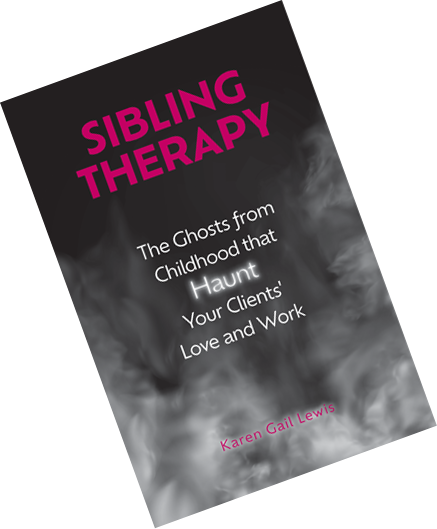
Read more about this book
For therapists of all orientations, this book is the first to provide a theoretical framework and treatment for working with adult siblings. It also offers help in understanding the sibling influences of your clients, whether in individual, couples, or family therapy, especially when dealing with seemingly intractable problems
Are You A Sibling? How Childhood Relationships Affect Your Love and Work
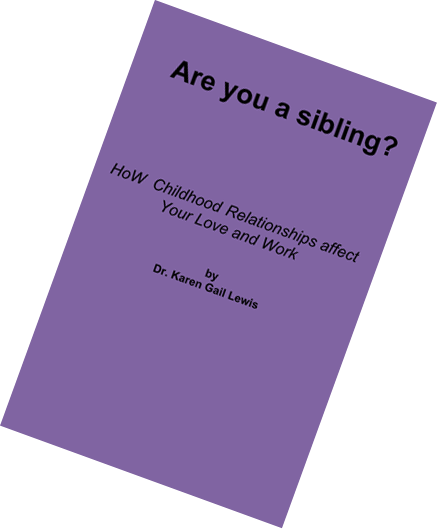
Read more about this book
Learn how the qualities of your early sibling relationships may have become frozen, affecting how you see each other as adults. Family roles and unhealthy sibling loyalties from childhood may be transferred to other people in your life, impacting your relationships with loved ones, friends, and even your success at work. FREE DOWNLOAD
FREE
eBook
Download for FREE
Siblings In Therapy
Life Span and Clinical Issues
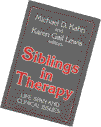
Read more about this book
Siblings in Therapy: Life Span and Clinical Issues
Co-edited by Michael Kahn and Karen Gail Lewis
(W.W.Norton, N.Y., 1988)
Table of Contents:
Acknowledgments
General Introduction
I. SIBLING DYNAMICS: GENERAL ISSUES
Introduction
- Intense Sibling Relationships: A Self-Psychological View – Michael D. Kahn
- Enchantment of Siblings: Effects of Birth Order and Trance on Family Myth – Morton S. Perlmutter
- Basics of Family Structure and Sibling Position – Walter Toman
- Ethnic Patterns and Sibling Relationships – Eve Primpas Harriman Welts
II. WHEN SIBLINGS ARE CLOSE: THE EARLY YEARS
Introduction
- Young Siblings in Brief Therapy – Karen Gail Lewis
- Clinical Interventions With Large Family Systems: Balancing Interests Through Siblings – Dennis E. McGuire and Patrick Tolan
- Untangling Incestuous Bonds: The Treatment of Sibling Incest – Marsha L. Heiman
- Psychotherapy with Siblings of Disabled Children – Milton Seligman
- When Parents Separate or Divorce: The Sibling System – Lee Combrinck-Graham
- Stepsiblings in Therapy – Elinor Rosenberg
- Children of Alcoholics: Their Sibling World – Rosalie C. Jesse
III. BALANCING CLOSENESS AND SEPARATENESS
LATE ADOLESCDENCE AND EARLY ADULT YEARS
Introduction
- Symptoms as Sibling Messages – Karen Gail Lewis
- The Tilted Family – Clark W. Falconer and Colin A. Ross
- The Vortex: Siblings in the Eating Disordered Family – Laura Giat Roberto
- My Brother’s Keeper: Siblings of Chronic Patients as Allies in Family Treatment – Ethan G. Harris
IV. SETTLING OLD SCORES: THE MIDDLE YEARS
Introduction
- The Stolen Birthright: The Adult Sibling in Individual Therapy – Stephen Pl. Bank
- Blueprints from the Past: A Character Work Perspective on Siblings and Personality Formation – Sandra Watanabe-Hammond
- Siblings and the Family Business – Robert Carroll
- Sibling Issues in Cotherapy and Coauthoring – William J. Doherty
V. FACING THE PROBLEMS OF AGING: THE LATE YEARS
Introduction
- Relationships Among Adult Siblings Who Care for Their Aged Parents – Mario Tonti
- Interpersonal Relationships Among Elderly Siblings – Victor G. Cicirelli
Index
Marriage Therapy Books
Why Don’t You Understand?
A Gender Relationship Dictionary
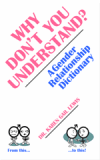
Read more about this book
Why Don’t You Understand?
The World’s First Gender Relationship Dictionary
Everyone knows that men and women are different; the words Mars and Venus have become part of American language to reflect gender differences. Yet, even with this common acceptance and the numerous books about differences between the sexes, couples continue to unintentionally hurt each other.
My research shows that over 60% of relationship problems are a result of couples not being bi-lingual, that is not being fluent in both Male-ese and Female-ese. Knowing there are gender differences does not help couples recognize when they have tripped a gender land-mine or know what they could do differently.
With over 70 terms defined in both languages — Male-ese and Female-ese — couples can become bilingual. This is the first book to translate the different meanings of gender-informed words and phrases, highlighting where couples get stuck, and what you can do to avoid miscommunication. There are examples of a Good Argument, documenting how each person can speak in the other’s language, and opportunities to practice being bilingual.
Why Don’t You Understand? is like having a pocket dictionary and road map while traveling in a foreign country.
The Secret To a Solid Marriage
Understanding Gender Differences
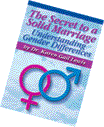
Read more about this book
Couples get married assuming they will love each other for ever. Yet, the adjustment of combining two different personalities and the stresses of every day life often throw ashes on the wedding bliss.
The Secret to a Solid Marriage demonstrates some typical struggles that occur when a husband and wife must contend with their different personalities and with the stresses of everyday life. At the end of each of these 12 stories, there are five questions to help you apply the issues and resolutions from the stories to your own marriage.
Stories For Your Marriage
How To Deal with The Tough Times
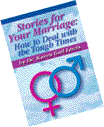
Read more about this book
Many marriages go through some tough periods. Stories for uour Marriage offers ideas for moving through these difficult times. These are stories taken (and appropriately disguised for confidentiality) from my clinical practice. Part One, “Recapture the Magic of your Marriage,” has eight stories focusing on different ways and exercises to recapture what once was so special.
Part Two is called “To Go or Not to Go: That is the Question.” These eleven stories present different ways to consider this question for your own marriage.
Single Women Books
With or Without a Man
Single Women Taking Control of Their Lives
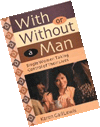
Read more about this book
INTRODUCTION
If it weren’t for wanting to be with a man, the single life can be quite satisfying
Research shows what single women already know: They can have a rich and fulfilling life without marriage. In fact, they often are more self-reliant and feel more centered than their married friends since they have had more space to devote to their self-development.
With or Without a Man starts with the premise that you know how to meet men and what to do on dates. It makes the assumption that you, like most women, are working on your personal growth — either through having read books, talked with friends, or been in therapy.
With or Without a Man is different from other self-help books in its explanation for why there are so many single women today: More women than men are pursuing their personal growth, so more women than men are ready for a healthy relationship. And, women only want to be with emotionally healthy men.
We live in a society that values marriage as the “norm.” If that value judgment were removed, being married and being single would be two equally viable paths through adulthood. There would be no need for women to blame themselves for being single.
Life is full of ambiguities, and for single women, a major one is not knowing if you’ll meet a suitable man for a long-term relationship or marriage.
If you are in love, at this point in your life you know that is not enough. Being in love is wonderful; there’s a deep sense of connection and mutual nurturing. But, loving a man who cannot make a commitment to you, or who blocks your personal or professional growth, or who is not emotionally available, or who is emotionally or physically abusive is nether wonderful nor enough.
The reality is that whether or not a woman has a relationship with a man, she may feel something is missing if she isn’t meeting her needs in the other areas of her life, separate from that relationship. These needs include a connection with close friends and a nurturance that comes from being involved in meaningful work or an avocation.
Since love is not static — there are romantic highs, times of being bored and unappreciated, unnerving arguments, the quiet depth of affection — you need a life that is rewarding, especially during the low points in a relationship, or if that relationship ends. As a single woman, you have no control over meeting an emotionally available man, but you do have control over including intimacy and internal fulfillment in your life. This book describes nine tasks to help you do this.
Table of Contents for With or Without a Man
- A Up-Close and Personal Look at Today’s Single Women
- Messages and Self-Blame
- Do Something! The Effect of the Messages
- Being Grounded
- Meeting Your Basic Needs
- Making a Decision About Children
- Enjoying Intimacy
- Hope for Horniness-Facing Your Sexual Feelings
- Men! Clarifying Your Thinking About Them
- Grieving
- Making Peace With Your Parents
- Preparing For Old Age
- Teaching Men
- Therapy For Single Women
- A Different View of Being Single
Workbook For With or Without a Man
(Manual)

Read more about this manual
Excerpt from the Introduction
This Workbook can serve as a rallying point for women, individually and in small groups, to work toward personal change and productive social change. Thirty exercises are divided into four sequential parts to guide you along the way. They move from recognizing how societal messages have become ingrained and effect how you feel about yourself, to shifting your thinking, to making change –- creating your own messages, to dealing differently with family, friends, and society.
Part 1, “Recognize How You’ve Absorbed The Messages,” helps you realize the power and negative influence of the messages you’ve heard from early childhood right up to the present. These are the messages that say being married has more value than being single, and you should be married. Before any change can occur, though, you first need to be clear about the effect of these unconsciously internalized messages.
Part 2, “Shift Your Thinking,” has nine exercises that offer new perspectives on how you can treat yourself and think about your past and your future as a single.
Part 3, “Fighting the Blues,” offers a number of other possible explanations for why you may be sad or depressed — not necessarily because you do not have a man. These exercises help assess if you are depriving yourself of intimacy or a good social life; if you are leading a boring, unfulfilling life.
Part 4, “Changing: You Can Make A Difference,” challenges you to take specific actions — individually, within your family, and in the larger community. These exercises may not leave you feeling better about being single, but they will move you away from blaming yourself for being single and give you direction for working toward a cultural change.
HOW TO USE THIS WORKBOOK
You can use this workbook on your own or as part of a discussion group. If you choose to use it with other women, the group can select one or two exercises to work on at home and to discuss at the next meeting.
The discussion can focus on how family members’ and society’s expectations have shaped women’s initial reaction to the exercises. Each meeting can end with women asserting an action plan for themselves. This can be something they will do differently — within themselves, with family members, or in the larger community — before the next group meeting. And, the group can take action together. Remember, change occurs when there is personal growth and a unified voice.
THE EXERCISES
Each exercise has a specific goal and a number of steps. At the end of each goal, in parentheses, are page numbers that refer back to pages in With Or Without A Man. Each exercise is followed by a Worksheet for noting your responses. However, you may prefer to choose your own journal or notebook. There is also space for noting your insights as you work the exercises.
You will need colored pens or makers. The only other tools you will need for working the exercises are your imagination and your willingness to no longer be affected by society’s messages that you should be married.
You are now ready to take steps to change how you see yourself as a single and to help society react differently to singles.
TABLE OF CONTENTS
| INTRODUCTION | …………………………………………………………………………… | 1 |
| Part 1 | RECOGNIZE HOW YOU’VE ABSORBED MESSAGES | |
| Exercise 1 | Messages From Childhood About The Importance Of Being Married | 7 |
| Exercise 2 | Messages From Childhood That Taught You To Not Trust Your Feelings | 9 |
| Exercise 3 | Social Messages That Say Being Married Has More Value Than Being Single | 11 |
| Exercise 4 | Longing To Be Married | 13 |
| Exercise 5 | Stop The Self-Blame | 16 |
| Part 2 | SHIFT YOUR THINKING | |
| Exercise 6 | Advantages And Drawbacks Of Being Single | 20 |
| Exercise 7 | What You Miss But May Not Have To Do Without | 23 |
| Exercise 8 | Crystal Ball: If You Could Look Into The Future | 26 |
| Exercise 9 | Don’t Be Cruel – To Yourself | 29 |
| Exercise 10 | Grieve Over Lost Dreams | 32 |
| Exercise 11 | It’s Not Your Fault: From Depression To Ambiguous Loss | 35 |
| Exercise 12 | You Are Not A “Spinster” | 38 |
| Exercise 13 | Honoring Your Accomplishments | 40 |
| Exercise 14 | Do You Want To Be A Mom? | 43 |
| Part 3 | FIGHTING THE BLUES | |
| Exercise 15 | Maybe Your Sadness Is About Not Having Your Intimacy Needs Met | 48 |
| Exercise 16 | Maybe Your Sadness Is About Not Having Your Physical Needs Met | 52 |
| Exercise 17 | Maybe Your Sadness Is About Not Having A Rich Social Life | 55 |
| Exercise 18 | Maybe Some Of Your Sadness Is Not Yours: The Grief Circle | 58 |
| Exercise 19 | Being Single Does Take More Planning | 61 |
| Exercise 20 | Being Different With Men | 65 |
| Exercise 21 | Your Life Has Meaning: Creating Your Life Scrapbook | 68 |
| Part 4 | CHANGING: YOU CAN MAKE A DIFFERENCE | |
| Exercise 22 | Retire The Old Messages About Being Single | 72 |
| Exercise 23 | Create Your Own Messages About Being Single | 74 |
| Exercise 24 | If You Had A Man | 77 |
| Exercise 25 | Change Undoable Goals to Doable Goals | 80 |
| Exercise 26 | Twenty Five Things You Want To Do Before You Die | 83 |
| Exercise 27 | Alternative Responses To “Are You Married?” | 85 |
| Exercise 28 | Men Aren’t So Fragile | 88 |
| Exercise 29 | Find Meaning In Being Single | 91 |
| Exercise 30 | Taking Control: Steps Towards Change | 94 |
| Author’s Note |
11 Stories on Being Single in a Married World
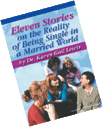
Read more about this book
11 Stories on the Reality of Being Single in a Married World shows some of the complexity and societal biases single women confront. They each debunk “self-blame” and end with ways women can handle these situations and feel good about themselves.
7 Shocking Truths about Being Single in a Married World
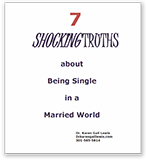
Read more about this book
Table of Contents
1st Truth: STOP: You May Not Need To Blame Yourself
2nd Truth: The Real Reason So Many Women are Single and Single Again
3rd Truth: Explaining Why You are Single Actually Makes You Feel Worse
4th Truth: The Effect of Touch Deprivation on Singles has Never Been Studied
5th Truth: You Can Have Intimacy Without Having a Man
6th Truth: Worst Part of Being Single? It’s Not the Absence of a Man
7th Truth: Politics Matters for Single Women
Other Books By Dr. Lewis
Family Systems Application to Social Work
Training and Clinical Practice
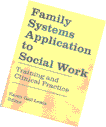
Variations on Teaching and Supervising Group Therapy
Your Love and Work

Getting Started is Easy
Free 20 Min Chat
Call to discuss your needs.
Call for Appointment
Call or Email to begin your journey.
1st Session!
Let's get started healing together.
Contact Me
Ask a question or call for a secure virtual session for people in the U.S. and internationally.
For emergencies call 911 or visit your nearest hospital.
